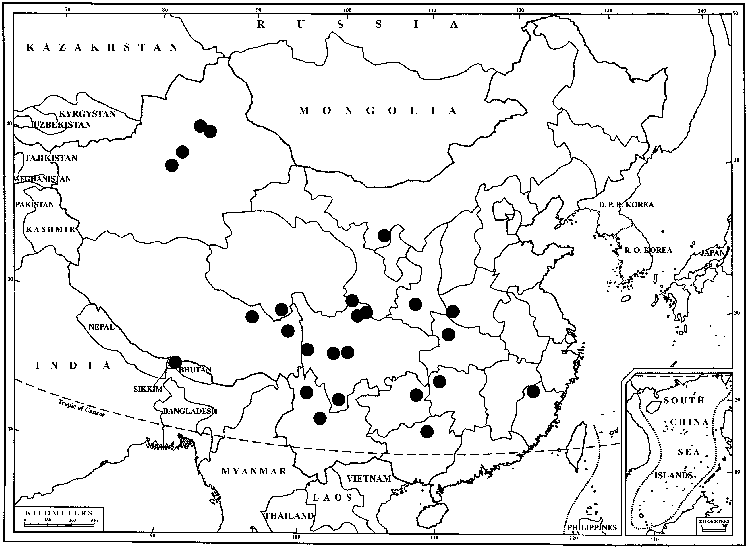Tortella fragilis
Laubm. Deutschl. 1: 606. 1888,.
Plants coarse, rigid, dark green to yellowish or blackish brown, elongate. Stems (0.5–) 1–5 cm, leaves distantly disposed along the stem with shining leaf-bases usually apparent, central strand absent, densely and visibly radiculose the entire stem length, rarely somewhat tomentose when very small. Stem-leaves firm, coarse, rigid, uniform in size and shape along the stem and apex, lowermost leaves mostly without leaf tips, leaves typically fragile only at base of deciduous apical subula, stiffly erect-appressed, incurved (or stem-apical leaves somewhat twisted around the stem when dry); erect and weakly spreading when moist, narrowly lanceolate to linear, narrowing gradually into the distal region until contracting into a narrower propaguloid region up to 1/2 the distal leaf length; broadly to narrowly concave, keeled toward the apex in nonpropaguloid leaves, 4–6 mm; base broadly oblong; margins plane to erect, not to somewhat undulate; apex narrowly acute, those of nonmodified leaves shallowly channeled to subnaviculate, not cucullate, those of modified leaves long-subulate, fragile, the subula obtusely thickened and multistratose distally and often broken off, youngest leaves arising from the stem apex fully propagulose and subulate; costa short-excurrent as a smooth or weakly denticulate mucro of 1–5 rhomboidal cells, in propaguloid leaves, internal cells in section appearing undifferentiated in the subula; adaxial surface covered by quadrate to shortrectangular, papillose laminal cells throughout the leaf except in the propaguloid leaf portion where a narrow medial groove covered by elongate (8:1) smooth cells; cross-section lunate and broad, adaxial epidermal-cells may interrupted in the center, exposing the adaxial stereid layer by about two cells in width, in propaguloid leaves stereid layers appear undifferentiated in the subula; proximal laminal cells rather abruptly differentiated from distal cells, yellow-hyaline, elongate, firm to laxly thin-walled, smooth; margin with a narrow line of firm to thin-walled cells extending a short way up the lamina or to midleaf; distal laminal cells frequently 2-stratose on one or both laminae beside the costa, or equally extending toward the margins in various degrees, and becoming completely 2-stratose and ultimately undifferentiated in the, deciduous leaf tips, roundedquadrate or hexagonal, (9–) 10–12 (–13) µm wide, strongly papillose, areolation more or less distinct; marginal cells in median leaf region undifferentiated, papillose-crenulate, along the distal median margin and into the subula differentiated as one or two rows of smooth, thick-walled, shortrectangular, (4–3:1), epapillose, yellowish cells leading into the subulate region and extending to the apex distinctly visible in at least some leaves, sometimes present only in young leaves on mature stems. Specialized asexual reproduction by deciduous, subulate, rigid, smooth-sided, distally thickened apices of all leaves. Sexual condition dioicous; perigonia not seen; perichaetial leaves setaceous, fragile, with propaguloid modifications as in stem-leaves. Seta 1.5–2 cm, occasionally two per perichaetium. Capsule 1.8–3 mm; annulus none or of 1–2 rows of weakly vesiculose cells, operculum ca. 1.5 mm; peristome teeth long, spirally wound, twisted 1–3 times.
Habitat: Seldom fruiting, capsules mature summer (Jun). Substrates probably dessicated some of the year, acid or calcareous rock, seepage, crevices and ledges of cliffs in maritime situations, dry prairies, logs or peaty humus in springs, fens, Thuja swamps, open sands of lake shores, tundra, alpine and willow bogs, frost boils, margins of solifluction lobes, snow patch margins
Elevation: low to high elevations (0-3600 m)
Distribution

Greenland, Alta., B.C., Man., N.B., Nfld. and Labr. (Labr.), N.W.T., N.S., Nunavut, Ont., Que., Yukon, Alaska, Colo., Iowa, Mich., Minn., Mont., Nev., N.J., N.Y., N.C., N.Dak., Oreg., S.Dak., Tenn., Vt., Wash., Wyo., Europe, Asia, Africa, Atlantic Islands (Iceland), Pacific Islands (New Zealand), Australasia, Antarctica
Discussion
The long, subulate, rigid, usually fragile leaves with propaguloid tips that are not or only slightly contorted when dry are distinctive of Tortella fragilis. In ambiguous cases, the 2-stratose cross section of the distal leaves is diagnostic, but usually all that is necessary for identification is to demonstrate the smooth, elongate, thicker-walled cells along the leaf margin near the apex. The leaves may be stiff and merely arcuate in some plants, in others variously to strongly contorted-circinate, but not crisped. Such plants may be difficult to distinguish from Tortella tortuosa var. fragilifolia, which, however, has a fragile leaf lamina in addition to fragile leaf apices
Quadrate, papillose epidermal cells across the adaxial portion of the costa occur throughout the leaf of Tortella fragilis except in the proximal cell region and in the propaguloid-setaceous part of the leaf where the costa is often exposed in a continuous groove of elongate cells. This character is useful in distinguishing the species from T. rigens, which has a continuous band of smooth, elongate cells on the adaxial surface of the costa throughout the length of the leaf.
Selected References
None.